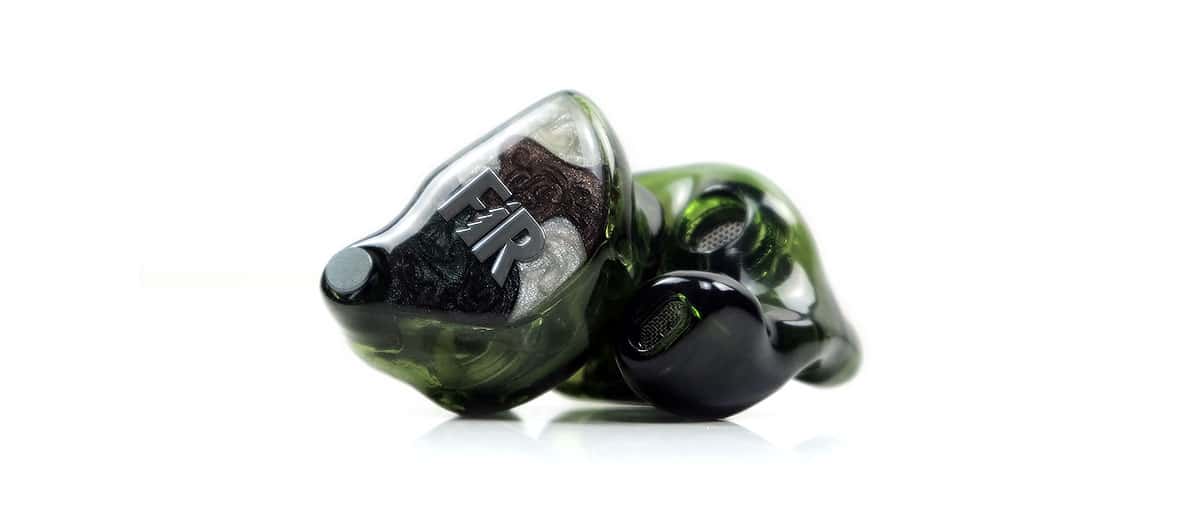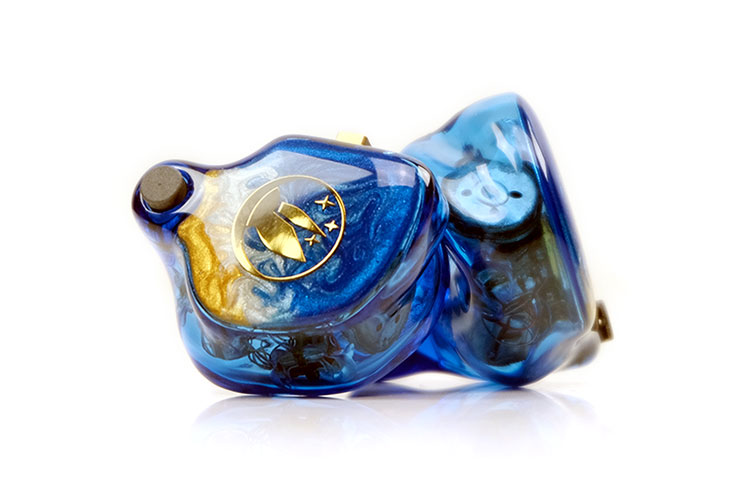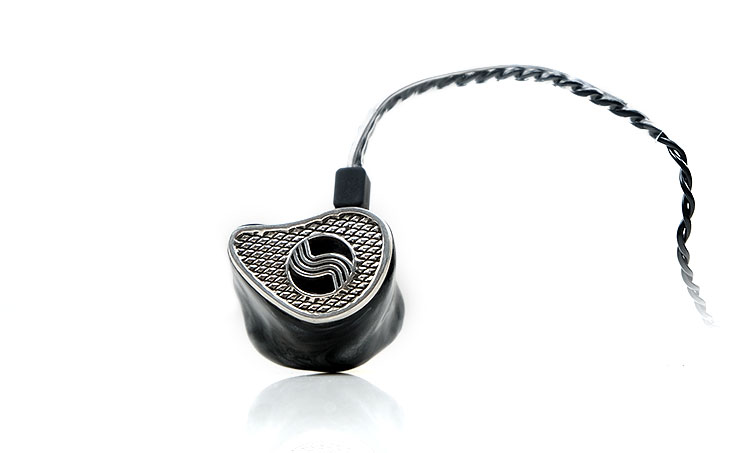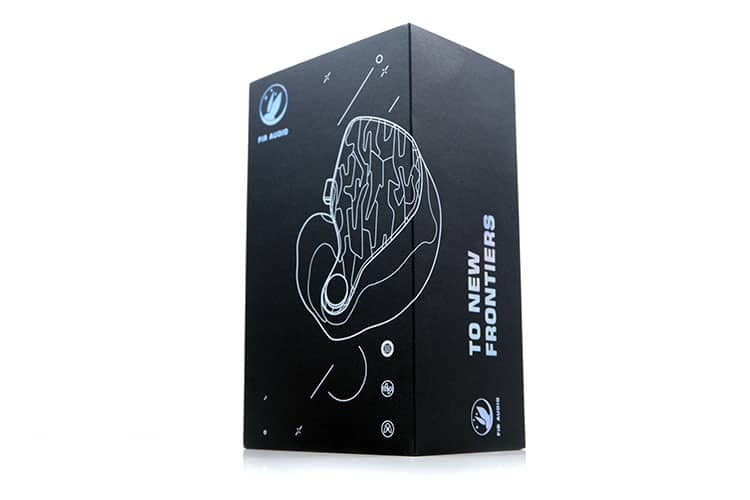Select Comparisons
All comparisons were completed using the HiBy RS8 and the LP P6 Pro as sources and in the case of the M5 comparison, the silver -15dB ATOM module for both monitors.
FiR Audio M5
The FiR Audio M5 is the flagship monitor of FiR Audio’s long-standing M-Series monitors and comes in custom or universal format. You can read our full review of the M5 custom version from early 2021 here.
$2799
Technical
A different choice of drivers but with an overlap of some key tech features. Both are hybrid 5-driver models with our two here custom though you can get both also in universal.
The M5 uses a single dynamic, a triple BA, and a single electrostatic driver. The precise configuration is the dynamic driver for the lows and mids, the BA for the mid-highs and highs, and the electrostatic driver for the ultra-highs.
The Krypton 5 differs with its Kinetic 10mm dynamic driver for the lows and 4 BA split between the lows, two for the mids and one for the highs.
The key shared characteristic is that all the BA drivers are tubeless though the M5 tech is called Direct Aperture Acoustics as opposed to the Krypton 5’s Open Acoustics system. Both are the same tech, just it has evolved a bit since the M5.
Both IEMs use the ATOM system. You also have a choice with both to use the internal ATOM filter or the swappable external ones if you buy the custom format. The filters are the same for both IEMs with matching dB Isolation and color schemes.
The M5 is rated at a fairly low 6.8Ω impedance level but without an official SPL rating. The Krypton 5 is similarly spec’d with no SPL but with a higher 22Ω impedance level. Neither are that hard to drive.
From our testing on the HiBy RS8 and the LP P6 Pro, both via low gain balanced, the Krypton 5 was a little bit more sensitive than the M5. I suspect the electrostatic driver inside the M5 is pulling down its sensitivity level which is the norm for drivers of these types.
Design
Since both are custom the aesthetics are quite different though you can tell from the design discussion of personal preference in this review that there is a common theme – blended complementary colors.
The M5 uses FiR Audio’s “Galaxy” series of color schemes with this particular one a mix of gold and blue swirl called Atlantis. It is a nice contrast to the darker organic green, brown, and silver of the Krypton 5 camo collage.
Both are finished with the ATOM venting system at the bottom corner of the faceplate and work exactly in the same manner so if you have both they are interchangeable.
The form factor on both differs slightly with the M5 the slightly bigger of the two, which I presume is due to the fitting for the electrostatic driver and transformer. The comfort levels are exactly the same as they should be given they are custom designed for my ear.
What is slightly different is the level of passive isolation with the M5 doing slightly better. The kinetic bass vent of the Krypton 5 does leak a little bit more than the M5 which has nothing similar.
The M5 sample here is finished with the RCX connection system and it is indeed much more robust compared to the Krypton 5 2-pin variant but you can have both with either 2-pin or RCX depending on your preference. It is nice to see both in action though.
A final note, the stock cable on the M5 here is an older basic version of what you see now with the Krypton 5 but all current M5 units will come with the same updated cable so no difference.
Performance
The Krypton 5 hits a lot harder than the M5. The bass amplitude from the Krypton 5 is more elevated and extends further up the FR to around 200-300Hz before it starts dropping down.
That means a more intense rumble and a denser mid-bass punch from the Krypton 5. The M5 has some nice rumble but is generally on the politer side. If you want the best note fundamental then Krypton 5 will give it.
The cut in the lower mids is a little more forceful on the Krypton 5 to prevent bass bleed, something that is not there on the M5 which tends to stay fairly linear to slightly elevated up to 1k giving upper bass to lower mid instruments some decent presence.
Where I find another difference between these two, aside from the bass, is the mids tuning and how much treble overtone creeps into the timbre.
The M5 runs a bit north of neutral from 2-5k which gives the vocal and percussion a bit of a lift. It is not a hugely extended treble, in fact, beyond 7k it fades before the EST drivers kick in a little north of 10k.
Still, you get a more filled-in and cleaner upper mids performance from the M5 compared to the Krypton 5 which is a little south of the ideal target amplitude curve save for a decent 1-2k bump.
Vocals are reasonably forward on the Krypton 5 but not as forward as the M5 with less treble overtone either so they sound a little darker to my ear, a little smoother and denser also.
The Krypton 5 has some nice treble sparkle around 8k but the 2-5k sub-target curve dip just drops the energy through the upper mids a touch hence that darker comment.
JH Audio Sharona
The Sharona is JH Audio’s current flagship monitor and as far as I can see from their website it is currently only offered in a custom format. You can read our full review of Sharona from earlier this year here.
$2299
Technical
The Sharona is a grandiose affair when it comes to driver counts with no less than 16 drivers per shall, all balanced armature, and all proprietary JH Audio quad packs. The key quad pack is the new Rau Quad Supertweeter for the highs which are exclusive to JH Audio and co-designed with Knowles with an excellent treble extension.
The Krypton 5 is far simpler in terms of sheer numbers but no less complex in the type of driver with a hybrid mix of that Kinetic 10mm dynamic driver and 4 BA split among the lows, mids, and highs. You will definitely hear a difference in the lows between these two.
If FiR is the master of tubeless then JH Audio is the king of tubes and both concepts are central to these 2 custom monitors.
The Sharona uses JH Audio’s FREQ|PHASE tech for accurate phase timing. This means the low, mid, and high BA drivers are positioned differently with different tube lengths to account for the speed of each driver to avoid cancellation issues at the various crossover points.
The Krypton 5 does away with tubes with the use of the Open Acoustics system to maximize the staging quality of the performance. Both BA and the dynamic driver are vented/ported with an acoustic design to manage it including the internal sound reflector and reactor.
The JH Audio Sharona is rated at 16Ω and 114dB SPL so slightly lower in terms of impedance compared to the Krypton 5 which is rated at 22Ω, though not significant. No SPL rating for the Krypton 5 but it does get louder faster on the low gain SE setting of the RS8 so technically it could be higher than 114dB.
Design
The Krypton 5 design is tight but I have to admit the aesthetics and materials used on the Sharona are stunning.
JH Audio really go all out with their Cobalt Signature Design though it will add $400 onto the base price of the custom design bringing it a lot closer to the Krypton 5 cost. I still think the Jolene brass and tan combo sample we have here is the peak of JH Audio’s creative powers but even so, the hyper-black and 3-dimensional metal plate are very eye-catching.
The Sharona is a bigger monitor than the Krypton 5 but is not ear-busting like the Jolene and Layla samples we have here. Considerable work was done to improve the comfort of their designs with the Sharona their most comfortable and compact to date.
Still, it did take something away from the isolation level of the Sharona, and whilst it is a little bit better than the vented Krypton 5 it is not at the same level as the Jolene. You trade a bit of comfort for isolation performance, so take your pick as to what is more important for you.
The Sharona we have here uses the IPX cable system which I quite like. It’s primarily aimed at stage artists with its easy snap-in and moisture protection rating. The Fir Audio RCX works on the robustness factor but has excellent protection also if you opt to use that format with the Krypton 5.
My only issue with the Sharona IPX is the recessed port making it very difficult to roll alternative cables with large jack barrels and you lose the bass control module. You can opt for a JH Audio 7-pin system but aftermarket cables, particularly those with bass modules can be pricey.
Performance
Two very different sound signatures primarily with different audiences in mind. The Sharona is expansive, perhaps casting a little wider than the Krypton 5, tuned with a creamy to sweet-sounding timbre and decidedly non-fatiguing. Just the type of tuning for long listening hours in a stage booth.
There is a sub-bass bias but it’s a BA texture rather than dynamic so not quite as aggressive. It does have an excellent mid-bass punch at volume. The Sharona is a bit more neutral for vocal imaging and through the mids, it’s effortless for detail and easy on the ear with a treble expansion that is excellent but hugely forward in presence.
The Krypton 5 is much more aggressive with its decidedly dynamic timbre on the lows and that Kinetic bass adding a bit more texture and rumble also. It hits a bit harder on the mid-bass as well.
However, unlike the L-shaped response of Sharona’s low-end, the Krypton 5 scoops the lower mids a bit more so it is not as warm through the mids and pushes up the 1-2k region for improved balance.
The Sharona 1-2k also has some amplitude but it never feels quite as forward or as intimate in its vocal imaging as the Krypton 5. I still consider the FiR tuning to be a bit south of neutral in terms of vocal forwardness and that 2-5k range is a little bit subdued in energy but not quite as relaxed as the Sharona equivalent.
The treble on the Krypton 5 is more forward and energetic sounding. The Sharona treble extension is excellent but comparatively relaxed in its imaging. That takes a little bit more contrast off the mids timbre which is a factor in its smoother tuning.
Unique Melody MEST MKII
Though we do have other bone conduction IEMs the MEST MKII is our only other format here that comes in a custom design similar to the Krypton 5. You can read our full review of the MEST MKII here.
$1799
Technical
Two bone conduction units go head-to-head, one almost half the price of the other. The MEST MKII does bone conduction very differently from the Krypton 5. Whilst integral to the overall presentation it is not a regular driver quite like the Kinetic Bass 10mm driver inside FiR’s creation.
The bone conduction driver in the MEST MKII is more of an outlier adding an additional layer on top of the core drivers from around the upper bass to the upper treble.
The rest of the MEST MKII setup is a hybrid mix of a single 10mm dynamic driver for the lows, a dual BA driver unit for the mids and upper mids, dual BA for the highs, and dual Sonion electrostatic drivers for the ultra-highs.
You could argue that it is a more complex setup than the tubeless 5-driver dynamic and BA mix inside the Krypton 5 but you have to remember these guys also worked on the tia Fourte from 64 Audio and that only had 4 drivers and no one thinks its a low-end performer.
Going tubeless with all of the drivers tends to bring surprising results, especially with that ported Kinetic Bass design included also.
The MEST MKII is rated at 12.3Ω and 112dB SPL so just a little bit less resistance than the 22Ω Krypton 5. As with most electrostatic driver monitors, the SPL is a bit lower with the Krypton 5 sounding the more sensitive of the two using a Cayin N8ii on a low-gain balanced output.
Design
Both are custom and both are green. What can I say, I like green though you are by no means restricted to green. This one is just a happy coincidence.
One thing to note is both companies do put some emphasis on toughening up their shells. Unique Melody does it by adding fibrous material into their carbon fiber black and green brushstroke design whereas FiR Audio gives the Krypton 5 resin shell an additional 20% thickness to protect it from potential cracks.
Courtesy of a few more drivers and an electrostatic energizer the MEST MKII is the bigger of the two customs designs externally though in the ear the fit should be the exact same save for some company preferences.
Both are comfortable and secure in your ear as you would expect from a pair of custom designs. However, the Krypton 5 passive isolation is just a step behind given it has that kinetic bass port which the UM design does not have.
I would also say the internal pressure of the MEST MKII is a bit more relaxed so stage artists might not be the priority market for them with this design. The MEST MKII has no ATOM-type filter system going with what they call a tuning vent for the dynamic driver instead.
This precisely sized metal vent is positioned in the same spot on the front plates as the Krypton 5 ATOM filer system and looks like a small hat with a hole in the middle.
Both of these monitor samples are fitted with flush 2-pin sockets but you can order an alternative RCX connection system for the Krypton 5. I am not entirely sure you can do that for the MEST MKII, at least not for the universal version which is a fixed 2-pin.
Performance
Both are aiming for a similar ballpark tuning with more of a showcase of their respective bone conduction/bass performance and a slight dip in the mids.
However, the intensity of the bass rumble and the mid-bass impact are more polite on the MEST MKII. It simply cannot match the Krypton 5 from 20Hz right up to 200Hz in sheer depth and power.
That has an effect on the lower-mid timbre and note fundamental with the Krypton 5 offering more authority for lower-pitching instruments and the MEST MKII coming off as slightly leaner in timbral weight and texture.
There is some enhanced treble presence on the MEST MKII from 5-10k and though not as amplified as the Krypton 5’s 8k sparkle, it does cover a wider bandwidth tweaking some of the mids timbre with a bit more sheen in the process.
Considering the lower levels of bass influence that tips the MEST MKII closer to neutral in coloration through the mids and the Krypton to the slightly darker and smoother side. It also elevated percussion a bit further forward with some enhanced shimmer in the very upper treble coming from those EST drivers.
With the Krypton 5, your ear is very much focused on the lower half of the FR with a much deeper staging quality with that thunderous bass and smoother thicker timbral performance for instruments and vocals.
Our Verdict
The FiR Audio Krypton 5 is one seriously impressive custom monitor with perhaps the most exciting or ‘driven’ tuning profiles I have heard this year in an IEM.
That Kinetic bass drops bombs left right and center without sounding fuzzy or overly bloomy. This is not a soft enveloping pillowy low-end, it’s firm, defined, and breathtaking in its execution.
It’s not all about the lows though. The harmonic balance is on point for my tastes, with nothing too sharp or warmed-up. Save for a bit of darkness in the upper mids this is a very balanced tuning. Give it power, give it good voltage and this CIEM will sound very energetic and lively.
Is it a reference-tuned offering? Nope, but sometimes being one of the best is not about being ruthlessly analytical, sometimes it can be hugely emotional also.
FiR Audio Krypton 5 Specifications
- 1x 10mm Kinetic Bass Dynamic Driver
- 1x OpenDriver Balanced Armature Driver for bass
- 2x OpenDriver Balanced Armature Driver for mids
- 1x OpenDriver Balanced Armature Driver for highs (with Sound Reflector)
- Freq. Range: 20-20kHz
- Impedance: 22ohms
- Leather Protective Case (Audiophiles)
- Free Custom Artwork & Premium Faceplates (CIEM)
- Internal ATOM and ATOM X Modules (CIEM)
- Aluminum Protective Case (Musicians)





